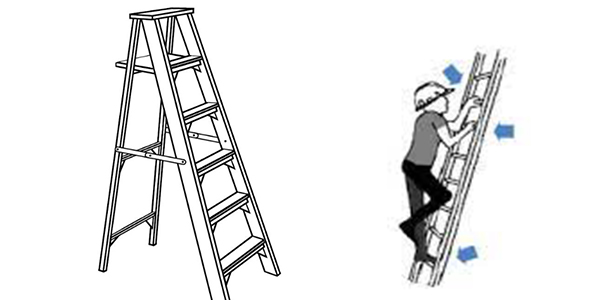Standard Ladder Widths: A Complete Guide for Safety and Efficiency
Apr 30, 2025Ladders are the most convenient tool for reaching heights on construction project sites. While determining the right width to choose when selecting a ladder for your construction project, it is important to understand that those decisions will impact its stability, convenience, and safety while using it. In this article, we will provide a complete overview of the common widths of ladders to make it easier for you to choose an appropriate ladder width for either your construction project or home tasks.

Standard Ladder Width Requirements: Covers a critical factor regulated by occupational safety agencies (OSHA, ANSI, EN) to ensure ladder stability.
Portable ladders: Side guardrails must be at least 11.5 inches (29 cm) apart (OSHA 1926.1053).
Fixed ladders: When permanently installed, rung width must be ≥16 inches (41 cm).
ANSI A14.2 (Metal Ladders): Type III (200 lbs. load) rung width requirement is ≥11.5 inches.
ANSI A14.5 (Reinforced Plastic Ladders): Heavy-duty models require a width of ≥12 inches.
Minimum single-section ladder width is 280 mm (11 inches).
Platform ladders: Standing area width is ≥400 mm (16 inches).
|
Ladder type |
Width |
Standards |
Applications |
Key Feature |
|
Step Ladders (A-Frame) |
12–20" (30–50 cm) |
OSHA ≥11.5", ANSI A14.2 |
Household repairs, painting, light maintenance |
Self-supporting; no need to lean against a surface |
|
Telescopic ladder |
14–18" (36–46 cm) |
EN131, OSHA 1926.1053 |
Roof access, construction, firefighting |
Adjustable length; requires a stable base |
|
Platform Ladders |
16–22" (40–56 cm)
|
OSHA 1910.23, ANSI A14.5 |
Prolonged tasks (e.g., electrical work, shelving) |
Integrated platform for standing comfort |
|
Multi-Position Ladders |
18–24" (46–61 cm) |
ANSI A14.5, EN131 |
Versatile use (e.g., stairways, uneven terrain) |
Configurable as step/extension/trestle ladder |
|
Industrial Ladders |
20–30" (50–76 cm) |
OSHA 1910.23 (≥16"), GB/T 17889 |
Warehouses, heavy-duty construction |
High load capacity (Type IAA, 375+ lbs) |

OSHA/ANSI/EN standards:
The minimum width of portable ladders is ≥11.5 inches (29 cm), and industrial ladders are recommended to be ≥16 inches (41 cm).
China's national standard (GB/T 17889) requires a static load of ≥1000N, and the width is directly related to the load-bearing capacity.
Risk of violation: Using a ladder that is too narrow (such as a household ladder to the construction site) may result in fines or accident liability.
High-altitude work (such as exterior wall construction):
Choose a telescopic ladder or platform ladder with a width of ≥18 inches (46 cm) to enhance stability.
Need to be equipped with non-slip pedals and guardrails (in compliance with OSHA 1910.23).
Narrow spaces (such as pipe rooms):
Use a foldable narrow ladder (width 12-14 inches), but limit the use time and strengthen supervision.
Load formula: For every 1-inch increase in width, the load-bearing capacity increases by approximately 20–30 lbs (reference ANSI A14 series).
Example: A 16-inch fiberglass ladder (Type IA, 300 lbs) is more suitable for workers to carry tools than a 12-inch ladder (Type III, 200 lbs).
Heavy equipment: Choose an industrial ladder ≥20 inches (such as a steel platform ladder) to move building materials.
Electric power work: A fiberglass ladder (insulated, width ≥18 inches) must be used.
Wet/corrosive environment: Aluminum ladder or fiberglass ladder (to avoid rust on steel ladders).
Advantages of wide ladders: Reduce worker fatigue and improve efficiency (such as platform ladders are suitable for 8-hour shifts).
Cost control: Narrow ladders are cheap, but may increase hidden costs for safety training or accidents.
Adhering to standard ladder width requirements ensures compliance with global safety regulations while optimizing user stability. Always prioritize width specifications that match your workload and regulatory environment to ensure your construction projects are safe.
If you need to choose a ladder with the right width, you can contact AJ Building for professional advice.
What are standard ladder dimensions?
Ladder dimensions typically range from 4 feet to 40 feet, depending on the type of ladder (e.g., stepladder, telescopic ladder, etc.).
What is the standard ladder width?
According to international standards, the minimum interior width of a portable ladder should be at least 11.5 inches (29 cm). However, industrial ladders or scaffolding ladders may be wider, typically between 16-20 inches (40-50 cm). For specific details, please refer to the ladder size table in the article.
Do different types of ladders have different widths?
Yes. Stepladders and telescopic ladders typically have wider rungs and frames, while loft ladders or telescoping ladders may be narrower to save space. Please refer to the ladder width standards for commercial use in your area.
What is the standard rung spacing of a ladder?
Standard ladder rung spacing is typically 12 inches (30 cm) center to center. This ensures comfortable and safe climbing and descending the ladder.
Access Ladder-Vertical Dimensions & Drawings —— Dimensions.com
Occupational Safety and Health Administration —— Occupational Safety and Health Administration (.gov)